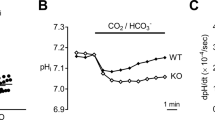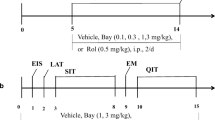Abstract
Rationale
The adenylyl cyclase (AC)/cAMP system is believed to be a key component in regulating alcohol-drinking behavior. It was reported that adenylyl cyclase-5 (AC5) is expressed widely in the brain, with a preferential concentration in the dorsal striatum and nucleus accumbens, brain regions which are important for addiction and emotion. AC5 has been shown to be an essential mediator of morphine addiction and dopamine receptor function; however, it remains unknown whether or not AC5 plays a role in ethanol preference and sensitivity in animals.
Objective
This work was carried out to determine the role of AC5 in alcohol consumption and the hypnotic response to alcohol using AC5 knockout (KO) mice.
Results
In the test for ethanol preference employing a two-bottle free-choice paradigm, AC5 KO mice showed increased ethanol consumption and preference compared with the wild-type mice. Ethanol-induced hypothermia was weakly reduced in AC5 KO mice. AC5 KO mice exhibited sedation/behavioral sleep to high-dose ethanol, but their responses were greatly suppressed compared with the wild-type mice.
Conclusions
These results suggest that AC5 is an important signaling molecule regulating alcohol sensitivity and preference in animals. These data provide critical information for AC5 activation as a candidate target for the treatment of alcoholism.




Similar content being viewed by others
References
Asyyed A, Storm D, Diamond I (2006) Ethanol activates cAMP response element-mediated gene expression in select regions of the mouse brain. Brain Res 1106(1):63–71
Bachmanov AA, Kiefer SW, Molina JC, Tordoff MG, Duffy VB, Bartoshuk LM, Mennella JA (2003) Chemosensory factors influencing alcohol perception, preferences, and consumption. Alcohol Clin Exp Res 27(2):220–231
Blednov YA, Walker D, Martinez M, Harris RA (2006) Reduced alcohol consumption in mice lacking preprodynorphin. Alcohol 40(2):73–86
Cali JJ, Zwaagstra C, Mons N, Cooper DMF, Krupinski J (1994) Type VIII adenylyl cyclase: a Ca2+/calmodulin stimulated enzyme expressed in discrete regions of rat brain. J Biol Chem 269:12190–12196
Chen J, Nam HW, Lee MR, Hinton DJ, Choi S, Kim T, Kawamura T, Janak PH, Choi DS (2010) Altered glutamatergic neurotransmission in the striatum regulates ethanol sensitivity and intake in mice lacking ENT1. Behav Brain Res 208:636–642
Davidson D, Palfai T, Bird C, Swift R (1999) Effects of naltrexone on alcohol self-administration in heavy drinkers. Alcohol Clin Exp Res 23(2):195–203
Hall FS, Sora I, Uhl GR (2001) Ethanol consumption and reward are decreased in mu-opiate receptor knockout mice. Psychopharmacology (Berl) 154(1):43–49
Hölter SM, Henniger MS, Lipkowski AW, Spanagel R (2000) Kappa-opioid receptors and relapse-like drinking in long-term ethanol-experienced rats. Psychopharmacology (Berl) 153(1):93–102
Hubbell CL, Czirr SA, Hunter GA, Beaman CM, LeCann NC, Reid LD (1986) Consumption of ethanol solution is potentiated by morphine and attenuated by naloxone persistently across repeated daily administrations. Alcohol 3(1):39–54
Kiefer SW, Hill KG, Kaczmarek HJ (1998) Taste reactivity to alcohol and basic tastes in outbred mice. Alcohol Clin Exp Res 22(5):1146–1151
Kim KS, Han PL (2009) Mice lacking adenylyl cyclase-5 cope badly with repeated restraint stress. J Neurosci Res 87(13):2983–2993
Kim KS, Lee KW, Lee KW, Im JY, Yoo JY, Kim SW, Lee JK, Nestler EJ, Han PL (2006) Adenylyl cyclase type 5 (AC5) is an essential mediator of morphine action. Proc Natl Acad Sci USA 103(10):3908–3913
Kim KS, Lee KW, Baek IS, Lim CM, Krishnan V, Lee JK, Nestler EJ, Han PL (2008) Adenylyl cyclase-5 activity in the nucleus accumbens regulates anxiety-related behavior. J Neurochem 107(1):105–115
Kovacs KM, Szakall I, O'Brien D, Wang R, Vinod KY, Saito M, Simonin F, Kieffer BL, Vadasz C (2005) Decreased oral self-administration of alcohol in kappa-opioid receptor knock-out mice. Alcohol Clin Exp Res 29(5):730–738
Lee KW, Hong JH, Choi IY, Che Y, Lee JK, Yang SD, Song CW, Kang HS, Lee JH, Noh JS, Shin HS, Han PL (2002) Impaired D2 dopamine receptor function in mice lacking type 5 adenylyl cyclase. J Neurosci 22:7931–7940
Levey AI, Hersch SM, Rye DB, Sunahara RK, Niznik HB, Kitt CA, Price DL, Maggio R, Brann MR, Ciliax BJ (1993) Localization of D1 and D2 dopamine receptors in brain with subtype-specific antibodies. Proc Natl Acad Sci USA 90(19):8861–8865
Lindholm S, Werme M, Brené S, Franck J (2001) The selective kappa-opioid receptor agonist U50, 488H attenuates voluntary ethanol intake in the rat. Behav Brain Res 120(2):137–146
Maas JW Jr, Vogt SK, Chan GC, Pineda VV, Storm DR, Muglia LJ (2005) Calcium-stimulated adenylyl cyclases are critical modulators of neuronal ethanol sensitivity. J Neurosci 25(16):4118–4126
Misra K, Pandey SC (2006) The decreased cyclic-AMP dependent-protein kinase A function in the nucleus accumbens: a role in alcohol drinking but not in anxiety-like behaviors in rats. Neuropsychopharmacology 31(7):1406–1419
Mucha RF, Herz A (1985) Motivational properties of kappa and mu opioid receptor agonists studied with place and taste preference conditioning. Psychopharmacology (Berl) 86(3):274–280
Nestler EJ, Carlezon WA Jr (2006) The mesolimbic dopamine reward circuit in depression. Biol Psychiatry 59(12):1151–1159
Nine JS, Moraca M, Virji MA, Rao KN (1995) Serum-ethanol determination: comparison of lactate and lactate dehydrogenase interference in three enzymatic assays. J Anal Toxicol 19(3):192–196
Pandey SC, Saito T, Yoshimura M, Sohma H, Götz ME (2001) cAMP signaling cascade: a promising role in ethanol tolerance and dependence. Alcohol Clin Exp Res 25((5 Suppl ISBRA)):46S–48S
Pandey SC, Roy A, Zhang H, Xu T (2004) Partial deletion of the cAMP response element-binding protein gene promotes alcohol-drinking behaviors. J Neurosci 24:5022–5030
Peng J, Wagle M, Mueller T, Mathur P, Lockwood BL, Bretaud S, Guo S (2009) Ethanol-modulated camouflage response screen in zebrafish uncovers a novel role for cAMP and extracellular signal-regulated kinase signaling in behavioral sensitivity to ethanol. J Neurosci 29(26):8408–8418
Roberts AJ, Gold LH, Polis I, McDonald JS, Filliol D, Kieffer BL, Koob GF (2001) Increased ethanol self-administration in delta-opioid receptor knockout mice. Alcohol Clin Exp Res 25(9):1249–1256
Sharko AC, Hodge CW (2008) Differential modulation of ethanol-induced sedation and hypnosis by metabotropic glutamate receptor antagonists in C57BL/6J mice. Alcohol Clin Exp Res 32(1):67–76
Shippenberg TS, Zapata A, Chefer VI (2007) Dynorphin and the pathophysiology of drug addiction. Pharmacol Ther 116(2):306–321
Silvestre JS, O'Neill MF, Fernandez AG, Palacios JM (1996) Effects of a range of dopamine receptor agonists and antagonists on ethanol intake in the rat. Eur J Pharmacol 318(2-3):257–265
Sunahara RK, Taussig R (2002) Isoforms of mammalian adenylyl cyclase: multiplicities of signaling. Mol Interv 2(3):168–184
Thiele TE, Willis B, Stadler J, Reynolds JG, Bernstein IL, McKnight GS (2000) High ethanol consumption and low sensitivity to ethanol-induced sedation in protein kinase A-mutant mice. J Neurosci 20(10):RC75
Wand G, Levine M, Zweifel L, Schwindinger W, Abel T (2001) The cAMP-protein kinase A signal transduction pathway modulates ethanol consumption and sedative effects of ethanol. J Neurosci 21(14):5297–5303
Weiss F, Mitchiner M, Bloom FE, Koob GF (1990) Free-choice responding for ethanol versus water in alcohol preferring (P) and unselected Wistar rats is differentially modified by naloxone, bromocriptine, and methysergide. Psychopharmacology (Berl) 101:178–186
Xia ZG, Refsdal CD, Merchant KM, Dorsa DM, Storm DR (1991) Distribution of mRNA for the calmodulin-sensitive adenylate cyclase in rat brain: expression in areas associated with learning and memory. Neuron 6:431–443
Yamamoto T (2003) Brain mechanisms of sweetness and palatability of sugars. Nutr Rev 61(5 Pt 2):S5–S9
Yang X, Horn K, Wand GS (1998) Chronic ethanol exposure impairs phosphorylation of CREB and CRE-binding activity in rat striatum. Alcohol Clin Exp Res 22(2):382–390
Yoshimura M, Tabakoff B (1995) Selective effects of ethanol on the generation of cAMP by particular members of the adenylyl cyclase family. Alcohol Clin Exp Res 19(6):1435–1440
Yoshimura M, Rabbani M, Bhave SV, Tabakoff B (1997) Isoform-specific enhancement of adenylyl cyclase activity by ethanol. Alcohol Clin Exp Res 21:40A
Acknowledgment
This research was supported by a grant (2010K000814) from Brain Research Center, The 21st Century Frontier Research Program of the Ministry of Education, Science and Technology, Republic of Korea.
Author information
Authors and Affiliations
Corresponding author
Rights and permissions
About this article
Cite this article
Kim, KS., Kim, H., Baek, IS. et al. Mice lacking adenylyl cyclase type 5 (AC5) show increased ethanol consumption and reduced ethanol sensitivity. Psychopharmacology 215, 391–398 (2011). https://doi.org/10.1007/s00213-010-2143-x
Received:
Accepted:
Published:
Issue Date:
DOI: https://doi.org/10.1007/s00213-010-2143-x




